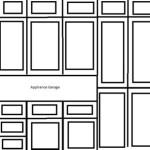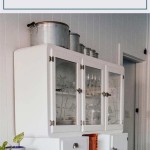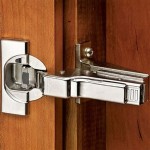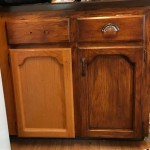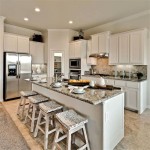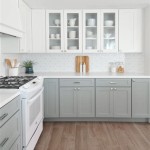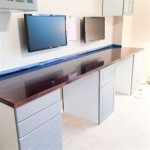How Deep Are Overhead Kitchen Cabinets? A Comprehensive Guide
Overhead kitchen cabinets, also known as wall cabinets, are a critical component of kitchen design, offering valuable storage space above the countertop. Determining the appropriate depth for these cabinets is essential for both functionality and aesthetics. The depth impacts the usability of the countertop, the comfort of the user, and the overall flow of the kitchen space. While a standard depth exists, understanding the nuances of cabinet depth allows for informed decisions when designing or renovating a kitchen.
Typically, overhead kitchen cabinets are shallower than base cabinets, which sit on the floor. This design difference prevents the user from bumping their head while working at the countertop. The standardized dimensions have evolved over time to accommodate common kitchen appliances and user ergonomics. However, variations exist based on design preferences, available space, and specific storage needs.
Factors influencing the optimal depth of overhead kitchen cabinets include the height of the user, the types of items to be stored, the presence of appliances like range hoods, and the overall kitchen layout. A well-planned cabinet depth enhances the functionality and visual appeal of the kitchen, while a poorly chosen depth can lead to inconvenience and wasted space.
Standard Depth of Overhead Kitchen Cabinets
The most common depth for overhead kitchen cabinets is 12 inches. This standard dimension provides sufficient storage for typical kitchen items like dishes, glasses, and smaller appliances. A 12-inch depth also allows for comfortable use of the countertop below, as it prevents the cabinets from feeling too intrusive. The 12-inch standard has become widely adopted by cabinet manufacturers, making it readily available and generally cost-effective.
The adoption of the 12-inch depth is rooted in practicality. It strikes a balance between maximizing storage capacity and minimizing interference with countertop activities. This depth is also compatible with most standard-sized dinner plates and serving dishes, ensuring that common kitchenware can be easily stored within the cabinets. Additionally, the standardized depth simplifies the installation process, as it allows for consistent spacing and alignment across the upper cabinets.
While 12 inches is the standard, it's crucial to measure existing items that will be stored in the cabinets to ensure the depth is adequate. Factors like oversized platters or infrequently used appliances may require adjustments to the standard depth. In such cases, customization may be necessary to optimize storage space and convenience.
Variations in Depth: When to Consider Alternatives
Although 12 inches is the standard, alternative depths for overhead kitchen cabinets are sometimes necessary or desirable. These variations cater to specific design requirements, spatial constraints, or storage needs. Common variations include shallower cabinets and deeper cabinets, each offering unique advantages and disadvantages.
Shallower cabinets, typically ranging from 9 to 10 inches deep, are often used in small kitchens or where space is limited. These cabinets can help to create a more open and airy feel, especially in cramped areas. They are also suitable for storing smaller items, such as spices, canned goods, or glassware. However, shallower cabinets offer less storage capacity and may not be able to accommodate larger items like dinner plates or mixing bowls.
Deeper cabinets, exceeding 12 inches, are used when increased storage capacity is desired. These cabinets are often found in kitchens where a larger volume of items needs to be stored, or where specific bulky items, such as large serving dishes or oversized appliances, need to be accommodated. Deeper cabinets can extend to 15 inches or even 18 inches in some cases. However, deeper cabinets can make the countertop feel more cramped and may require careful planning to ensure comfortable use of the workspace below. When installing deeper cabinets, the mounting hardware and support structure must be robust enough to handle the increased weight and depth.
Another variation is to use different depths for different cabinets within the same kitchen. For instance, cabinets above the refrigerator are often deeper than standard to align with the refrigerator's depth, creating a more integrated look. Cabinets above the range hood may also be shallower to provide adequate clearance and ventilation. The decision to use varying depths should be carefully considered to maintain a cohesive design and ensure optimal functionality.
Impact of Cabinet Depth on Kitchen Design and Functionality
The depth of overhead kitchen cabinets significantly impacts the overall design and functionality of the kitchen. It affects the visual appeal, the ergonomics of the workspace, and the ease of access to stored items. Careful consideration of cabinet depth can enhance the usability and aesthetic value of the kitchen.
Aesthetically, cabinet depth influences the visual balance of the kitchen. Deeper cabinets can create a more substantial and imposing look, while shallower cabinets can contribute to a more streamlined and minimalist appearance. The chosen depth should complement the overall style of the kitchen, whether it is modern, traditional, or transitional. The style of the cabinet doors and hardware also plays a role in the overall aesthetic, and these elements should be considered in conjunction with the cabinet depth.
Functionally, cabinet depth affects the ergonomics of the workspace. A well-chosen depth allows for comfortable use of the countertop without feeling cramped or restricted. Adequate space should be maintained between the countertop and the bottom of the overhead cabinets to allow for easy access to appliances and food preparation tasks. The height of the user should also be considered when determining the optimal depth, as taller individuals may require shallower cabinets to prevent bumping their heads.
The depth of the cabinets also impacts the accessibility of stored items. Deeper cabinets can make it more difficult to reach items at the back, especially for individuals with shorter arms. Using organizational tools, such as pull-out shelves or lazy Susans, can help to improve accessibility in deeper cabinets. Shallower cabinets, on the other hand, provide easier access to items but may limit the amount of storage space available.
The presence of appliances, such as range hoods and microwaves, also influences the optimal cabinet depth. Cabinets surrounding these appliances must be carefully planned to ensure proper clearance and ventilation. Range hoods, in particular, require sufficient space above the cooktop to effectively capture smoke and fumes. The manufacturer's specifications should be consulted when determining the appropriate cabinet depth for these areas.
Beyond the standard considerations of depth, the internal organization of cabinets matters significantly. Adjustable shelving allows for customization based on the items being stored, maximizing space utilization. Internal lighting can improve visibility, especially in deeper cabinets. The choice of shelving material, such as wood, wire, or glass, also affects the overall functionality and aesthetic appeal of the cabinets.
In conclusion, selecting the correct depth for overhead kitchen cabinets requires careful consideration of various factors, including available space, storage needs, and aesthetic preferences. While a 12-inch depth is the standard, understanding the advantages and disadvantages of alternative depths allows for a more personalized and functional kitchen design. By carefully evaluating these factors, homeowners and designers can create a kitchen that is both visually appealing and highly efficient.

Overhead Kitchen Cabinets Dimensions Google Search Measurements Height Cabinet Sizes

Get More Kitchen Storage With Counter Depth Upper Cabinets

Standard Kitchen Cabinet Dimensions For Your Homee Design Cafe

Standard Kitchen Cabinet Dimensions For Your Homee Design Cafe

Get More Kitchen Storage With Counter Depth Upper Cabinets

Get More Kitchen Storage With Counter Depth Upper Cabinets

Get More Kitchen Storage With Counter Depth Upper Cabinets

Kitchen Design Measurements You Need To Know Free Cheat Sheet

Get More Kitchen Storage With Counter Depth Upper Cabinets

How High Should You Hang Your Upper Kitchen Cabinets
Related Posts

